Numerical Assessment of the Hybrid Approach for Simulating Three-Dimensional Flow and Advective Transport in Fractured Rocks
Abstract
1. Introduction
2. Materials and Methods
2.1. Flow Equation
2.2. The Mesh Generations for the HD Model
2.3. Particle Tracking Algorithm for Advective Transport
3. Numerical Examples
3.1. Workflow for the Test Cases
3.2. The Conceptual Models of the Test Cases
3.3. The Software and Computational Meshes and Grids for the Test Cases
4. Results and Discussion
4.1. Flow Simulations Based on Different Models
4.2. Simulations of Advective Transport
5. Conclusions
Author Contributions
Funding
Institutional Review Board Statement
Informed Consent Statement
Data Availability Statement
Conflicts of Interest
References
- Dershowitz, W.; Ambrose, R.; Lim, D.H.; Cottrell, M. Hydraulic Fracture and Natural Fracture Simulation for Improved Shale Gas Development. In Proceedings of the AAPG Annual Convention and Exhibition, Houston, TX, USA, 10–13 April 2011. Search and Discovery Article #40797. [Google Scholar]
- Yan, B.; Mi, L.; Wang, Y.; Tang, H.; An, C.; Killough, J.E. Multi-porosity multi-physics compositional simulation for gas storage and transport in highly heterogeneous shales. J. Pet. Sci. Eng. 2018, 160, 498–509. [Google Scholar] [CrossRef]
- Wang, H.Y. Discrete fracture networks modeling of shale gas production and revisit rate transient analysis in heterogeneous fractured reservoirs. J. Pet. Sci. Eng. 2018, 169, 796–812. [Google Scholar] [CrossRef]
- AbuAisha, M.; Loret, B.; Eaton, D. Enhanced Geothermal Systems (EGS): Hydraulic fracturing in a thermo-poroelastic framework. J. Pet. Sci. Eng. 2016, 146, 1179–1191. [Google Scholar] [CrossRef]
- Svensk Kärnbränslehantering AB; POSIVA Oy. Safety Functions, Performance Targets and Technical Design Requirements for a KBS-3V Repository, Conclusion and Recommendations from a Joint SKB and Posiva Working Group; Posiva SKB Report, 01; Svensk Kärnbränslehantering AB: Stockholm, Sweden; POSIVA Oy: Eurajoki, Finland, 2017. [Google Scholar]
- Joyce, S.; Simpson, T.; Hartley, L.; Applegate, D.; Hoek, J.; Jackson, P.; Swan, D. Groundwater Flow Modelling of Periods with Temperate Climate Conditions—Forsmark; R-09-20; Svensk Kärnbränslehantering AB: Stockholm, Sweden, 2010. [Google Scholar]
- Hyman, J.D.; Gable, C.W.; Painter, S.L.; Makedonska, N. Conforming delaunay triangulation of stochastically generated three dimensional discrete fracture networks: A feature rejection algorithm for meshing strategy. J. Sci. Comput. 2014, 36, A1871–A1894. [Google Scholar] [CrossRef]
- Hyman, J.D.; Karra, S.; Makedonska, N.; Gable, C.W.; Painter, S.L.; Viswanathan, H.S. dfnWorks: A discrete fracture network framework for modeling subsurface flow and transport. Comput. Geosci. 2015, 84, 10–19. [Google Scholar] [CrossRef]
- Kalbacher, T.; Wang, W.; McDermott, C.; Kolditz, O.; Taniguchi, T. Development and application of a CAD interface for fractured rock. Eng. Geol. 2005, 47, 1017–1027. [Google Scholar] [CrossRef]
- Makedonska, N.; Painter, S.; Bui, Q.; Gable, C.; Karra, S. Particle tracking approach for transport in three-dimensional discrete fracture networks. Comput. Geosci. 2015, 19, 1123–1137. [Google Scholar] [CrossRef]
- Zhang, Q.H. Finite element generation of arbitrary 3-D fracture networks for flow analysis in complicated discrete fracture networks. J. Hydrol. 2015, 529, 890–908. [Google Scholar] [CrossRef]
- Chen, R.H.; Lee, C.H.; Chen, C.S. Evaluation of transport of radioactive contaminant in fractured rock. Environ. Geol. 2001, 41, 440–450. [Google Scholar] [CrossRef]
- Jing, L. A review of techniques, advances and outstanding issues in numerical modelling for rock mechanics and rock engineering. Int. J. Min. Reclam. Environ. 2003, 40, 283–353. [Google Scholar] [CrossRef]
- Rutqvist, J.; Leung, C.; Hoch, A.; Wang, Y.; Wang, Z. Linked multicontinuum and crack tensor approach for modeling of coupled geomechanics, fluid flow and transport in fractured rock. J. Rock Mech. Geotech. Eng. 2013, 5, 18–31. [Google Scholar] [CrossRef]
- Vu, P.T.; Ni, C.-F.; Li, W.-C.; Lee, I.-H.; Lin, C.-P. Particle-Based Workflow for Modeling Uncertainty of Reactive Transport in 3D Discrete Fracture Networks. Water 2019, 11, 2502. [Google Scholar] [CrossRef]
- Berrone, S.; Pieraccini, S.; Scialò, S. A PDE-constrained optimization formulation for discrete fracture network flows. J. Sci. Comput. 2013, 35, B487–B510. [Google Scholar] [CrossRef]
- Berrone, S.; Pieraccini, S.; Scialò, S. An optimization approach for large scale simulations of discrete fracture network flows. J. Comput. Phys. 2014, 256, 838–853. [Google Scholar] [CrossRef][Green Version]
- Neuman, S. Trends, prospects and challenges in quantifying flow and transport through fractured rocks. Hydrogeol. J. 2005, 13, 124–147. [Google Scholar] [CrossRef]
- Peratta, A.; Popov, V. A new scheme for numerical modelling of flow and transport processes in 3D fractured porous media. Adv. Water Resour. 2006, 29, 42–61. [Google Scholar] [CrossRef]
- Maryška, J.; Severýn, O.; Vohralík, M. Numerical simulation of fracture flow with a mixed-hybrid FEM stochastic discrete fracture network model. Comput. Geosci. 2005, 8, 217–234. [Google Scholar] [CrossRef]
- Berre, I.; Boon, W.; Flemisch, B.; Fumagalli, A.; Glaser, D.; Keilegavlen, E.; Scotti, A.; Stefansson, I.; Tatomir, A. Call for participation: Verification benchmarks for single-phase flow in three-dimensional fractured porous media. Math. NA 2018, 1809, 1–20. [Google Scholar]
- Berre, I.; Boon, W.M.; Flemisch, B.; Fumagalli, A.; Gläser, D.; Keilegavlen, E.; Scotti, A.; Stefansson, I.; Tatomir, A.; Brenner, K.; et al. Verification benchmarks for single-phase flow in three-dimensional fractured porous media. Adv. Water Resour. 2021, 147, 103759. [Google Scholar] [CrossRef]
- Li, S.C.; Xu, Z.H.; Ma, G.W.; Yang, W.M. An adaptive mesh refinement method for a medium with discrete fracture network: The enriched Persson’s method. Finite Elem. Anal. Des. 2014, 86, 41–50. [Google Scholar] [CrossRef]
- Wang, L.; Cardenas, M.B. An efficient quasi-3D particle tracking-based approach for transport through fractures with application to dynamic dispersion calculation. J. Contam. Hydrol. 2015, 179, 47–54. [Google Scholar] [CrossRef] [PubMed]
- Golder. Available online: https://www.golder.com/fracman/ (accessed on 3 October 2021).
- Golder. Fracman7 Interactive Discrete Feature Data Analysis, Geometric Modeling and Exploration Simulation; User Documenation; Golder Associates: Seattle, WA, USA, 2018; pp. 1–567. [Google Scholar]
- Svensson, U. A continuum representation of fracture networks. Part I: Method and basic test cases. J. Hydrol. 2001, 250, 170–186. [Google Scholar] [CrossRef]
- Svensson, U. A continuum representation of fracture networks. Part II: Application to the Äspö Hard Rock laboratory. J. Hydrol. 2001, 250, 187–205. [Google Scholar] [CrossRef]
- Svensson, U.; Ferry, M. DarcyTools: A computer code for hydrogeological analysis of nuclear waste repositories in fractured rock. J. Appl. Math. Phys. 2014, 2, 365–383. [Google Scholar] [CrossRef]
- Kwicklis, E.M.; Healy, R.W. Numerical investigation of steady liquid water flow in a variably saturated fracture network. Water Resour. Res. 1993, 29, 4091–4102. [Google Scholar] [CrossRef]
- Liu, H.H.; Bodvarsson, G.S.; Finsterle, S. A note on unsaturated flow in two-dimensional fracture networks. Water Resour. Res. 2002, 38, 15-1–15-9. [Google Scholar] [CrossRef]
- Pruess, K.; Tsang, Y.W. On two-phase relative permeability and capillary pressure of rough-walled rock fractures. Water Resour. Res. 1990, 26, 1915–1926. [Google Scholar] [CrossRef]
- Lee, I.H.; Ni, C.F. Fracture-based modeling of complex flow and CO2 migration in three-dimensional fractured rocks. Comput. Geosci. 2011, 81, 2270–2281. [Google Scholar] [CrossRef]
- Lee, I.H.; Ni, C.F.; Lin, F.P.; Lin, C.P.; Ke, C.C. Stochastic modeling of flow and conservative transport in three-dimensional discrete fracture networks. Hydrol. Earth Syst. Sci. 2019, 23, 19–34. [Google Scholar] [CrossRef]
- Mustapha, H.; Dimitrakopoulos, R.; Graf, T.; Firoozabadi, A. An efficient method for discretizing 3D fractured mediafor subsurface flow and transport simulations. Int. J. Numer. Meth. Fluids 2011, 81, 651–670. [Google Scholar] [CrossRef]
- Du, Q.; Wang, D. Recent progress in robust and quality Delaunay mesh generation. J. Comput. Appl. Math. Fluids 2006, 195, 8–23. [Google Scholar] [CrossRef]
- Ghadyani, H.; Sullivan, J.; Wu, Z. Boundary recovery for delaunay tetrahedral meshes using local topological transformations. Finite Elem. Anal. Des. 2010, 46, 74–83. [Google Scholar] [CrossRef]
- Sun, S.; Sui, J.; Chen, B.; Yuan, M. An efficient mesh generation method for fractured network system based on dynamic grid deformation. Math. Probl. Eng. 2013, 2013, 834908. [Google Scholar] [CrossRef]
- Zhang, Y.; Bajaj, C.; Sohn, B.S. 3D finite element meshing from imaging data. Comput. Methods Appl. Mech. Eng. 2005, 194, 5083–5106. [Google Scholar] [CrossRef]
- Hyman, J.D.; Painter, S.L.; Viswanathan, H.; Makedonska, N.; Karra, S. Influence of injection mode on transport properties in kilometer-scale three-dimensional discrete fracture networks. Water Resour. Res. 2015, 51, 7289–7308. [Google Scholar] [CrossRef]
- Painter, S.; Cvetkovic, V.; Mancillas, J.; Pensado, O. Time domain particle tracking methods for simulating transport with retention and first-order transformation. Water Resour. Res. 2008, 44, 1–11. [Google Scholar] [CrossRef]
- Kensler, A.; Shirley, P. Optimizing Ray-Triangle Intersection via Automated Search. In Proceedings of the IEEE Symposium on Interactive Ray Tracing, Salt Lake City, UT, USA, 18–20 September 2006. [Google Scholar]
- Fougerolle, Y.D.; Lanquetin, S.; Neveu, M.; Lauthelier, T. A Geometric Algorithm for Ray/Bézier Surfaces Intersection Using Quasi-Interpolating Control Net. In Proceedings of the IEEE International Conference on Signal Image Technology and Internet Based Systems, Bali, Indonesia, 30 November–3 December 2008. [Google Scholar]
- Maria, M.; Horna, S.; Aveneau, L. Efficient Ray Traversal of Constrained Delaunay Tetrahedralization. In Proceedings of the 12th International Joint Conference on Computer Vision, Imaging and Computer Graphics Theory and Applications (VISIGRAPP 2017), Porto, Portugal, 27 February–1 March 2017. [Google Scholar]
- Svensk Kärnbränslehantering AB. Buffer, Backfill and Closure Process Report for the Safety Assessment SR-Site; TR-10-47; Svensk Kärnbränslehantering AB: Stockholm, Sweden, 2010. [Google Scholar]
- Svensk Kärnbränslehantering AB. Radionuclide Transport Report for the Safety Assessment SR-Site; TR-10-50; Svensk Kärnbränslehantering AB: Stockholm, Sweden, 2010. [Google Scholar]
- Park, Y.L.; Lee, K.K.; Kosakowski, G.; Berkowitz, B. Transport behavior in three-dimensional fracture intersections. Water Resour. Res. 2003, 39, 1215. [Google Scholar] [CrossRef]
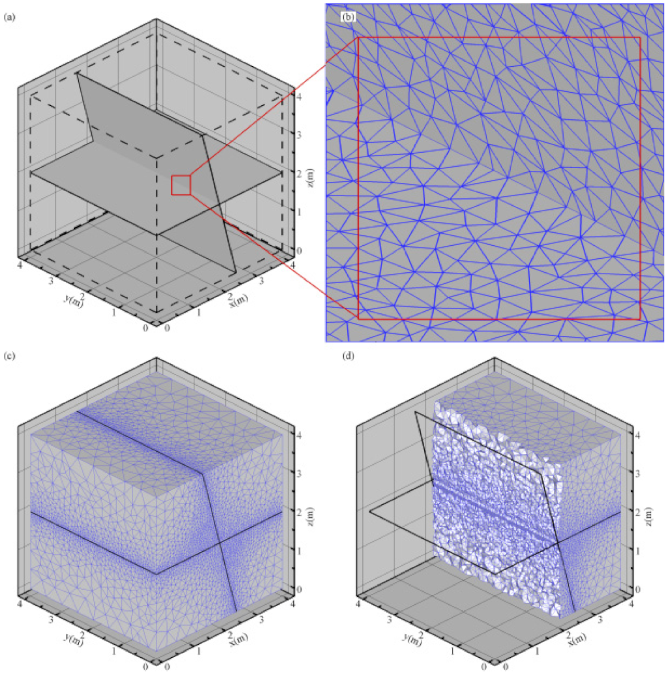
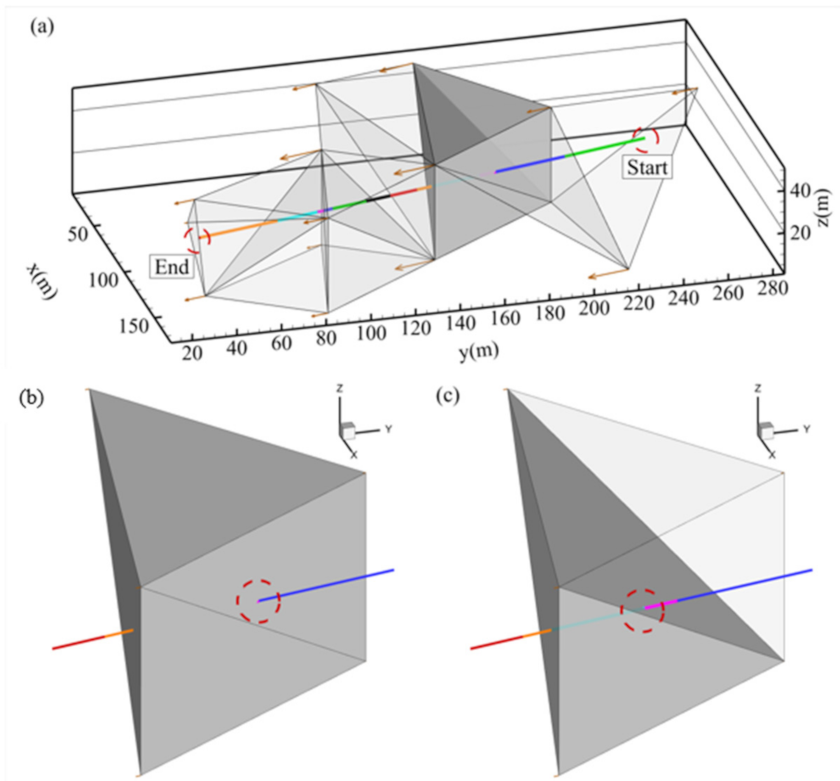
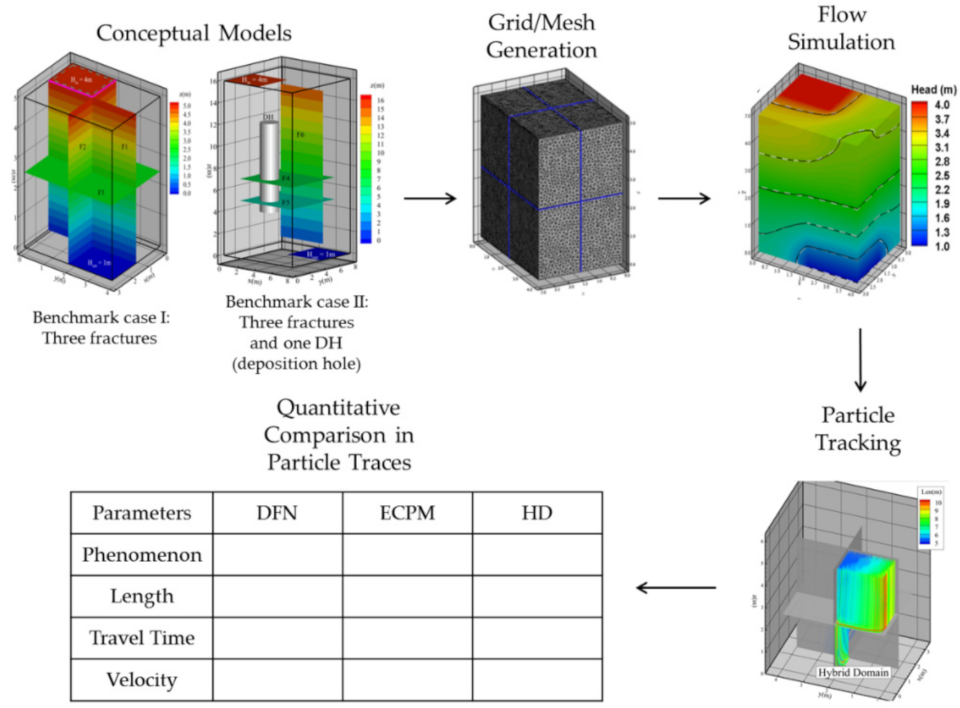
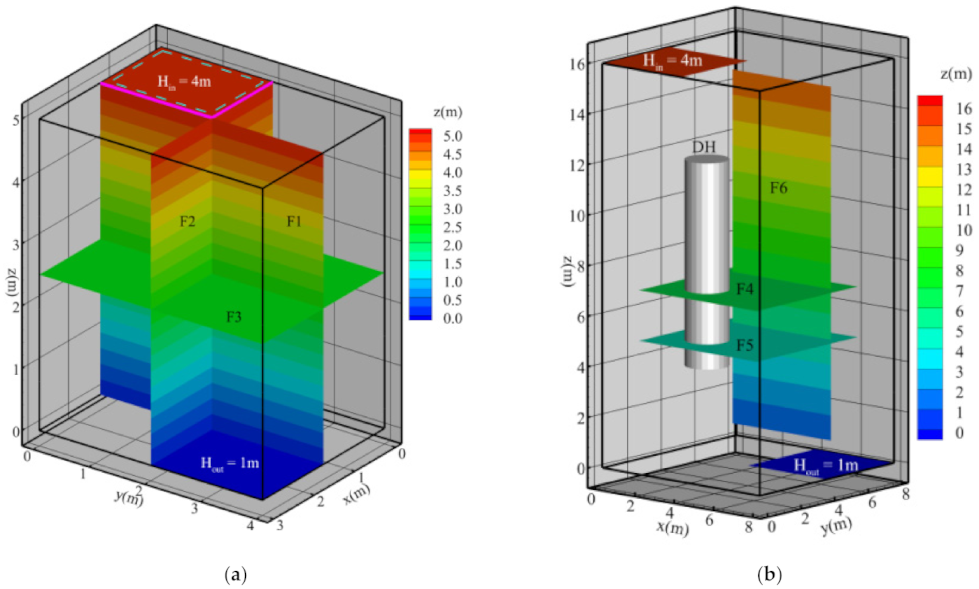
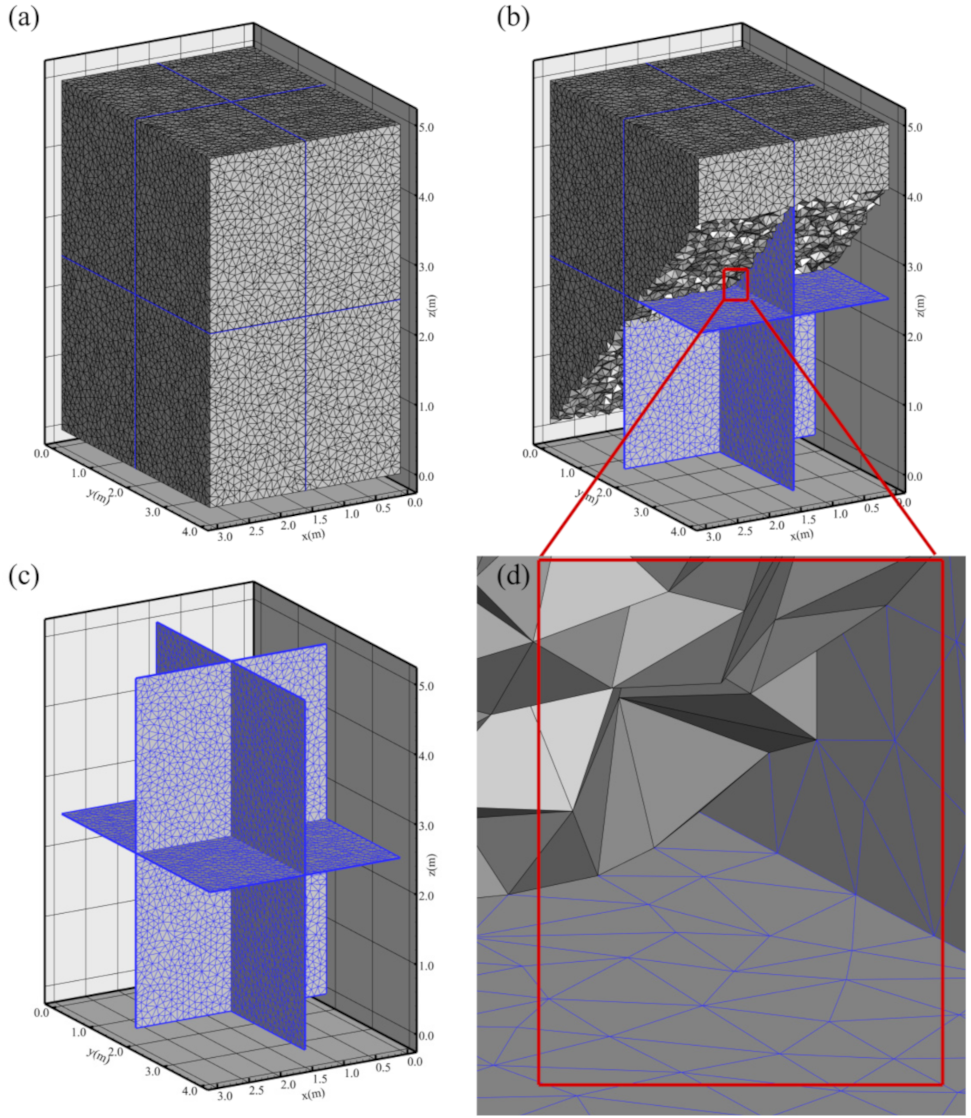
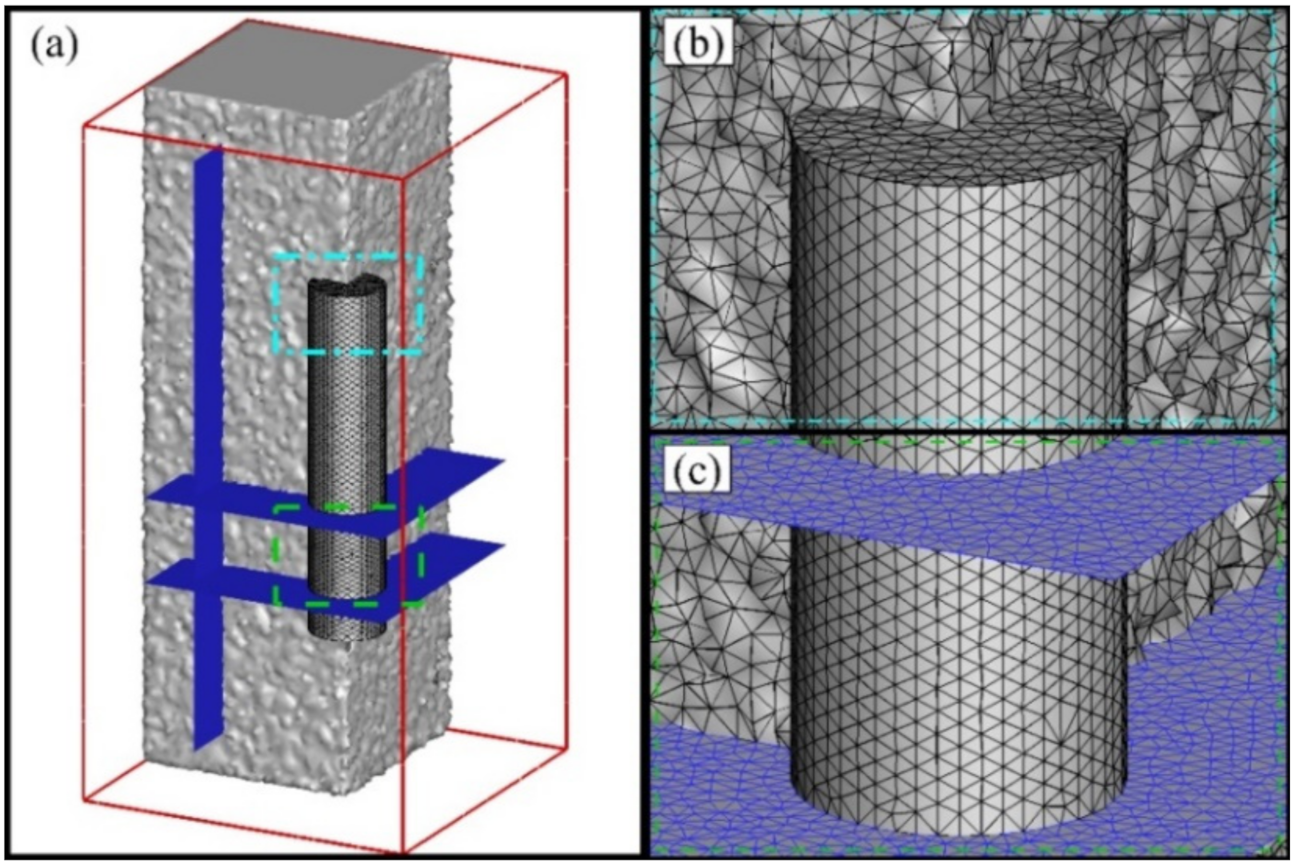
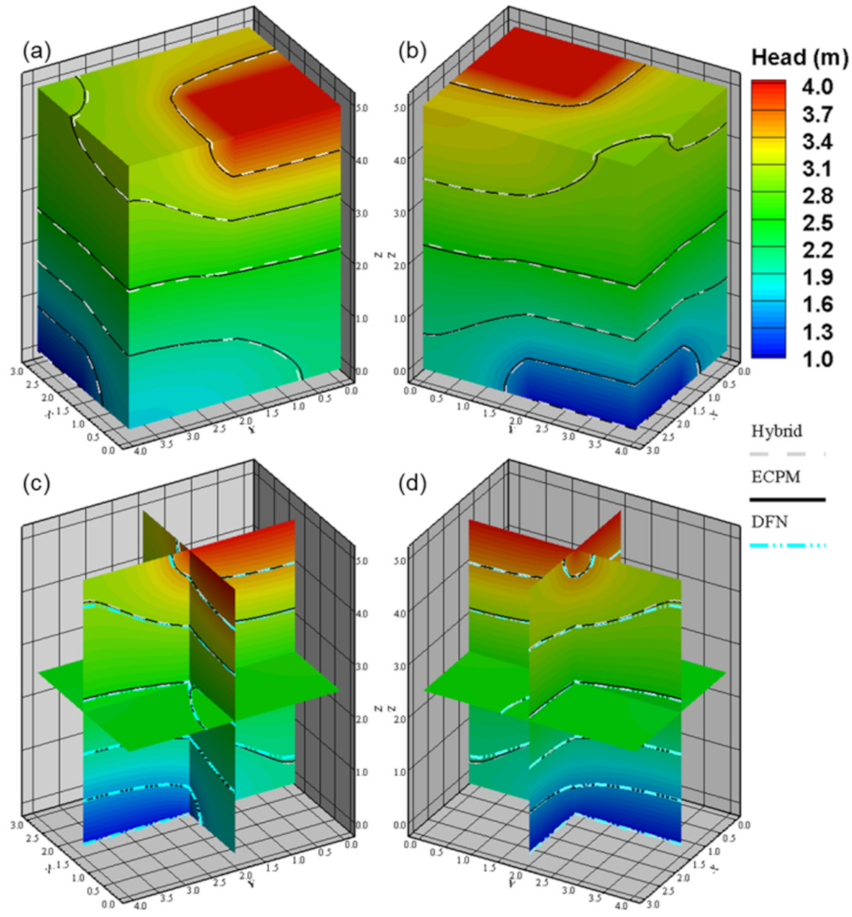
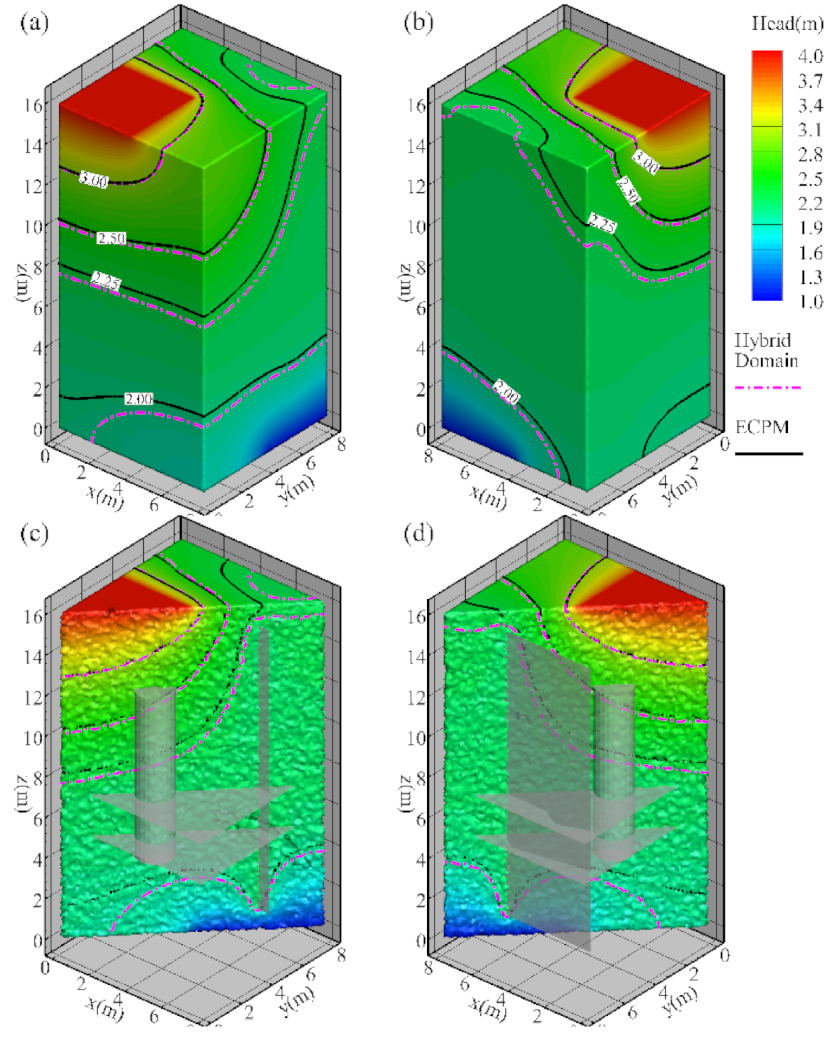
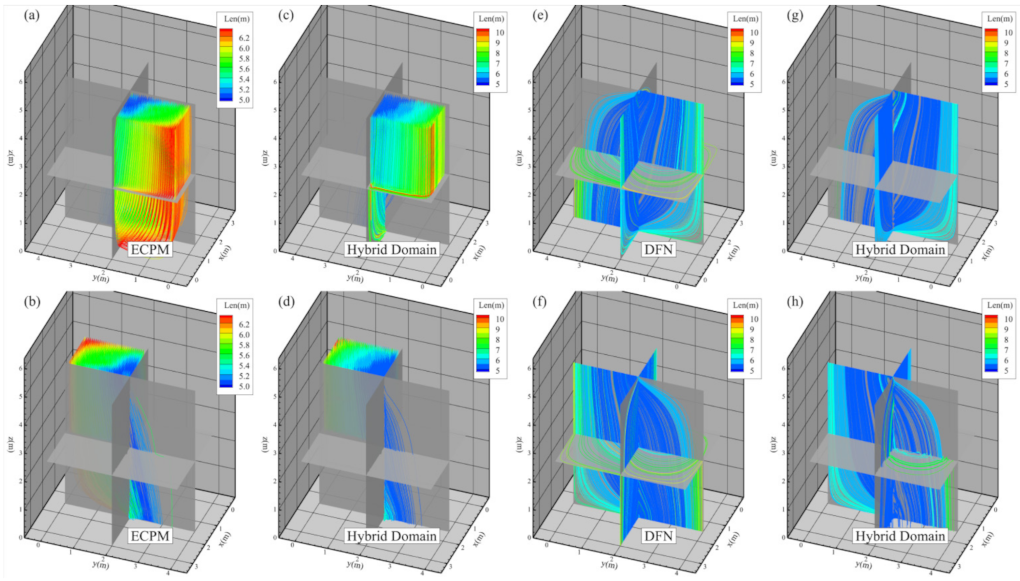
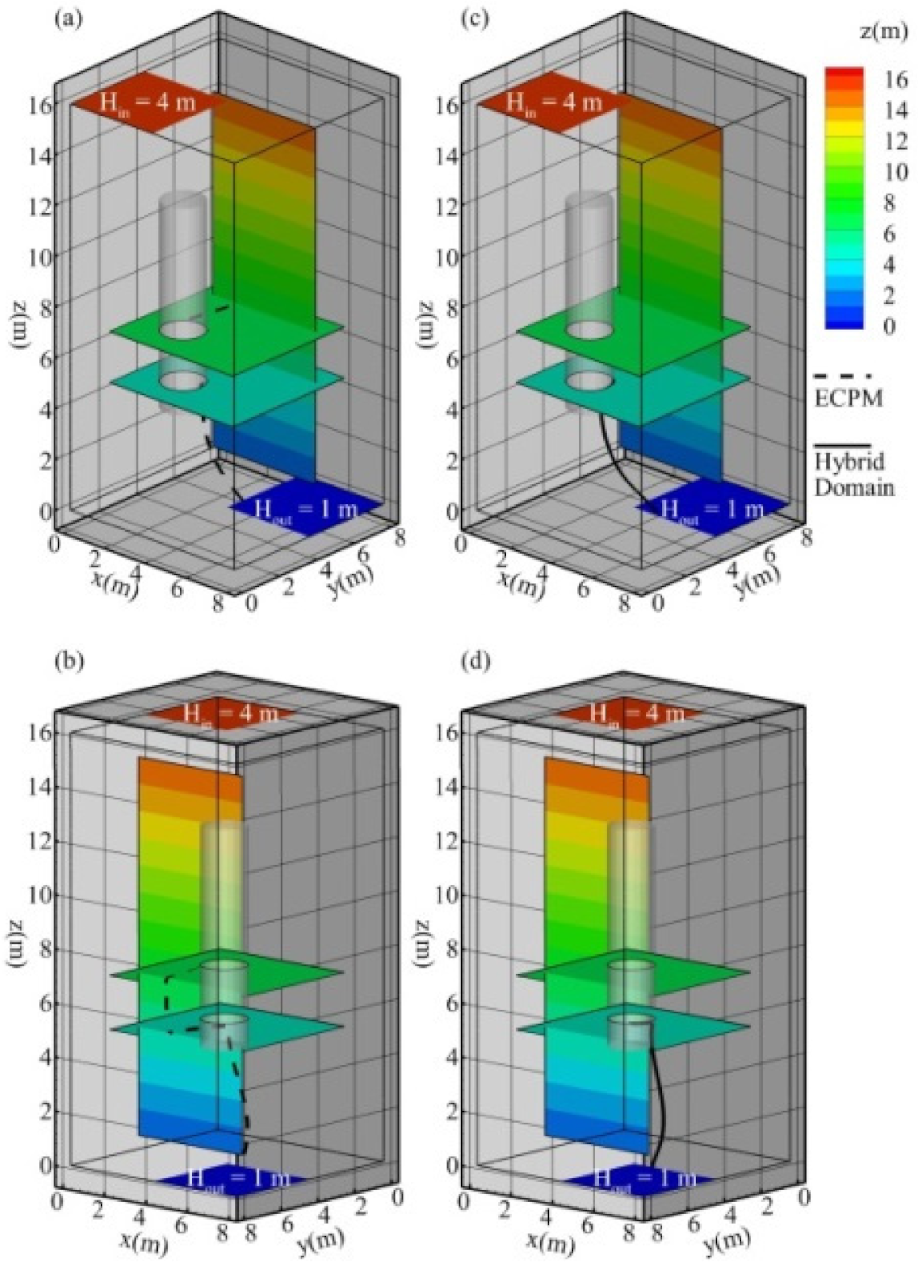
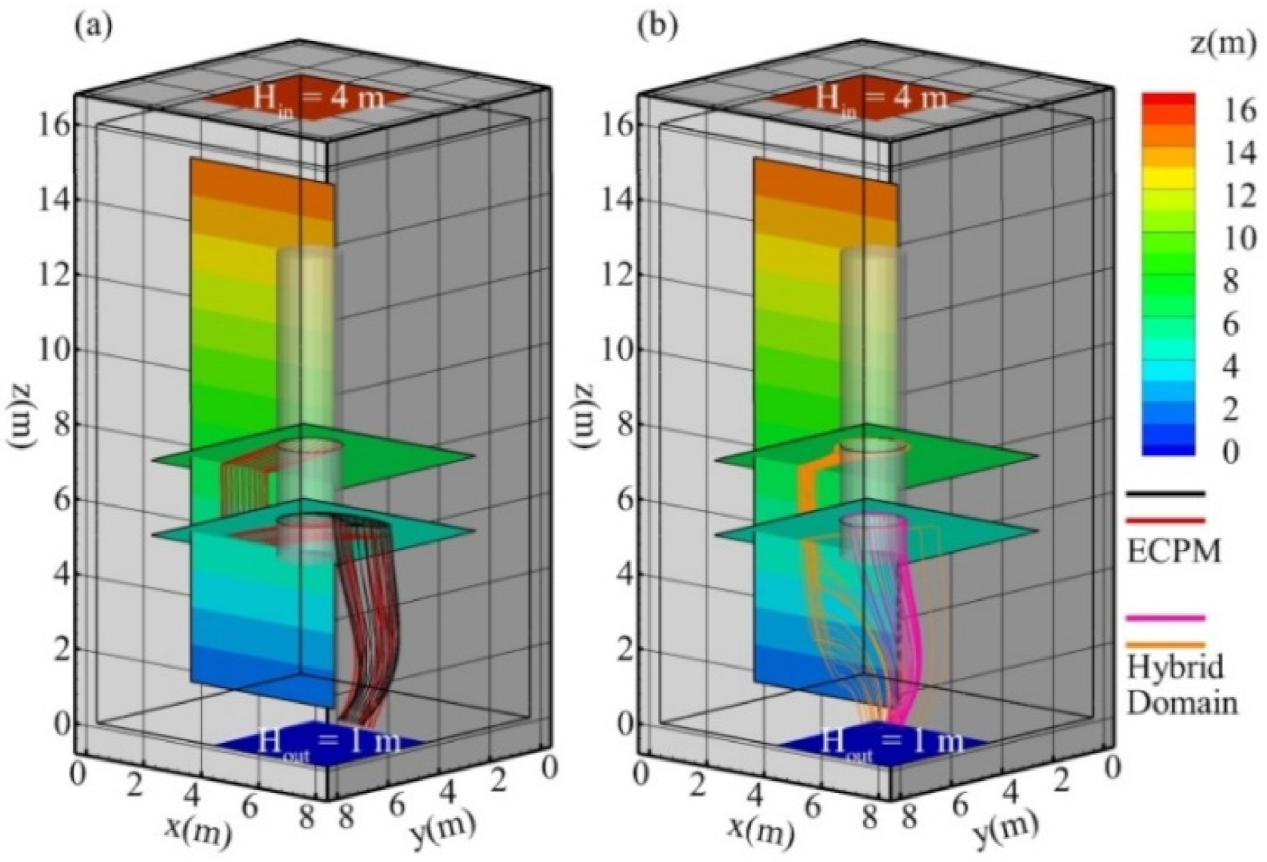
| Parameters | Case I | Case II |
|---|---|---|
| Fracture transmissivity (m2/s) | ||
| Matrix hydraulic conductivity (m/s) | ||
| Deposition hole hydraulic conductivity (m/s) | - | |
| Fracture aperture (m) | ||
| Fracture porosity (-) | ||
| Rock matrix porosity (-) | ||
| Convergence criteria (m) | ||
| Particle numbers (-) | 1000 | 1; 48 ** |
| Parameters | ECPM | HD (Fractures and Matrix) | DFN | HD (Fractures Only) | |
|---|---|---|---|---|---|
| Trace length | Mean (m) | 5.61 | 6.38 | 5.51 | 5.38 |
| STD (m) | 0.35 | 1.01 | 0.63 | 0.37 | |
| CV | 0.062 | 0.158 | 0.114 | 0.069 | |
| Min. (m) | 5.07 | 5.12 | 5.11 | 5.10 | |
| Max. (m) | 6.39 | 10.48 | 9.04 | 7.77 | |
| Travel time | Mean (s) | ||||
| STD (s) | |||||
| CV | 0.58 | 0.30 | 1.47 | 0.67 | |
| Min. (s) | |||||
| Max. (s) | |||||
| Velocity | Mean (m/s) | ||||
| STD (m/s) | |||||
| CV | 0.70 | 0.87 | 0.26 | 0.10 | |
| Min. (m/s) | |||||
| Max. (m/s) | |||||
| Parameters | ECPM Model | HD Model |
|---|---|---|
| Start location (x, y, z) (m) | 2.4375, 3.6875, 7.0625 | 3.390, 3.573, 5.000 |
| End location (x, y, z) (m) | 4.830, 4.147, 0.125 | 4.995, 4.114, 0.000 |
| Velocity at the start location (m/s) |
| Parameters | ECPM Model | HD Model | |
|---|---|---|---|
| Trace length | Mean (m) | 10.69 | 9.07 |
| STD (m) | 3.16 | 2.74 | |
| CV | 0.296 | 0.302 | |
| Min. (m) | 7.25 | 5.85 | |
| Max. (m) | 15.70 | 15.10 | |
| Travel time | Mean (s) | ||
| STD (s) | |||
| CV | 0.247 | 0.247 | |
| Min. (s) | |||
| Max. (s) | |||
| Velocity | Mean (m/s) | ||
| STD (m/s) | |||
| CV | 0.143 | 0.505 | |
| Min. (s) | |||
| Max. (s) | |||
Publisher’s Note: MDPI stays neutral with regard to jurisdictional claims in published maps and institutional affiliations. |
© 2021 by the authors. Licensee MDPI, Basel, Switzerland. This article is an open access article distributed under the terms and conditions of the Creative Commons Attribution (CC BY) license (https://creativecommons.org/licenses/by/4.0/).
Share and Cite
Yu, Y.-C.; Lee, I.-H.; Ni, C.-F.; Shen, Y.-H.; Tong, C.-Z.; Wu, Y.-C.; Lo, E. Numerical Assessment of the Hybrid Approach for Simulating Three-Dimensional Flow and Advective Transport in Fractured Rocks. Appl. Sci. 2021, 11, 10792. https://doi.org/10.3390/app112210792
Yu Y-C, Lee I-H, Ni C-F, Shen Y-H, Tong C-Z, Wu Y-C, Lo E. Numerical Assessment of the Hybrid Approach for Simulating Three-Dimensional Flow and Advective Transport in Fractured Rocks. Applied Sciences. 2021; 11(22):10792. https://doi.org/10.3390/app112210792
Chicago/Turabian StyleYu, Yun-Chen, I-Hsien Lee, Chuen-Fa Ni, Yu-Hsiang Shen, Cong-Zhang Tong, Yuan-Chieh Wu, and Emilie Lo. 2021. "Numerical Assessment of the Hybrid Approach for Simulating Three-Dimensional Flow and Advective Transport in Fractured Rocks" Applied Sciences 11, no. 22: 10792. https://doi.org/10.3390/app112210792
APA StyleYu, Y.-C., Lee, I.-H., Ni, C.-F., Shen, Y.-H., Tong, C.-Z., Wu, Y.-C., & Lo, E. (2021). Numerical Assessment of the Hybrid Approach for Simulating Three-Dimensional Flow and Advective Transport in Fractured Rocks. Applied Sciences, 11(22), 10792. https://doi.org/10.3390/app112210792







